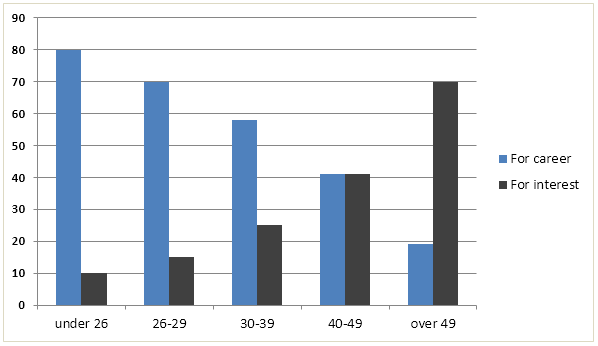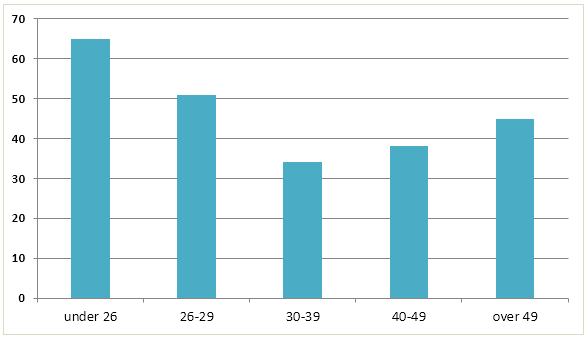» You should spend about 20 minutes on this task.
The charts below show the main reasons for study among students of different age groups and the amount of support they received from employers.
Summarise the information by selecting and reporting the main features, and make comparisons where relevant.
» Write at least 150 words.


Model Answer 1:
The bar chart delineates the ratio of pupils who continue their education for the benefit of their career and from passion, based on their age groups while the line graph reveals the support those students got from their companies as a form of financial support and time off.
Overall, young students’ main focus for education is their career while it was mostly passion for elder learners. Moreover, young students below 30 years of age received more support from their employers.
To illustrate, eight of ten people under 26 years old continue education for their career. Only 10% of them do it from passion. Interestingly, the higher the age, the more eager they become to study for personal interest, not for professional reasons. Seven out of ten people who are at least 50 years old study for interest. Finally, these two factors equally motivate people from 40-49 years old to further their learning.
The second diagram shows that young employees who were younger than 30 years old, got more backing from their employers while the least support is expected for workers between 30 to 39 years old. However, it is interesting to notice that employers were more sympathetic to workers over 40 years old than they were to employees in their thirties.
Sample Answer 2:
The diagrams outline why students from different age groups study and the support they received from their employers.
Overall, having a good career is the main reason for young to study while it is personal interest for grown-ups. Moreover, young employees got more support from their employers regarding their education.
According to the first bar graph, people who are under 40 years old mostly study for the career while people over 49 years mainly study for their interest. Interestingly for the age group 40 to 49, the number of people who study for career and the number of people who study for interest is the same. 80% students under 26 years continue their education to build a career. Seven out of ten students over 49 years old do so for their interest, rather than their career.
The second bar graph shows that more than 60% students under 26 years old got support from their employers for their education and this supports included the time off and monetary support. This percentage of support reduced with the increase of age of the learners, and at 30-39 age group, 32% got the support from the employers. After that, the employers’ support for their employees’ education increased and reached to 45% for the over 49 year’s age group.
Sample Answer 3:
The graphs illustrate why people from different age groups continue their studies and the support employers offered to them in terms of financial and time off.
Overall, it is obvious that there is a decreasing trend among students who study for their profession as they become older, whereas the reverse is true for those who study for passion.
It is apparent that the highest percentage of students (80%) study for their career and they are under 26 years old. Turning to the personal interest as a reason for the study, the higher the age, the ratio of pupil learning from passion increases. In addition, an equal percentage of people, aged 40 to 49, study for their career and interest in subjects.
The second bar chart reveals that the employers gave more support to their young employees (those under 26 years old) and elderly workers with the least support provided to those in the age range between 30 and 39 years old.
( Written by – Lee Wing Qeen )
Model Answer 4:
The charts depict why students at different ages study and also give information about the support (time off or financial aid) they received from their employers.
Overall, it is evident that young people (under 40 years) study because of their career prospects while the majority of older people study because of their interest.
With regard to motivations, the majority of people under 40 years study in order to promote their career, although this attitude varies depending on the age of polled people. To start with, 80% students under 26 years express that they study because of career preparation while just 10% study for interest in subjects. In older cohorts, 70% of 26-29 years old students and 58% of 30-39 years old students, say that career plays an important role, while in the group of 40-49, career and interest are similarly important. People over 49 mainly study because of interest (70%).
Regarding support they received from offices, approximately 62% of interviewees under 26 years said that they got support from their employers whereas the majority of students being older than 25 did not receive much help from their companies.
[Authored by – Jörn Matzen]
